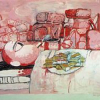Philip Guston

Philip Guston
Philip Guston, born Phillip Goldstein, was a painter and printmaker in the New York School, which included many of the abstract expressionists, such as Jackson Pollock and Willem de Kooning. In the late 1960s Guston helped to lead a transition from abstract expressionism to neo-expressionism in painting, abandoning the so-called "pure abstraction" of abstract expressionism in favor of more cartoonish renderings of various personal symbols and objects...
NationalityAmerican
ProfessionPainter
Date of Birth27 June 1913
CountryUnited States of America
I go to the studio everyday because one day I may go and the Angel will be there. What if I don't go and the Angel comes?
The things I felt... about certain painters of the past that... inspired me, like Cezanne and Manet... that complete losing of oneself in the work to such an extent that the work itself... felt as if a living organism was posited there on the canvas, on this surface... That's truly... the act of creation.
To paint is always to start at the beginning again, yet being unable to avoid the familiar arguments about what you see yourself painting.
Where do you put a form? It will move all around, bellow out and shrink, and sometimes it winds up where it was in the first place. But at the end it feels different, and it had to make the voyage. I am a moralist and cannot accept what has not been paid for, or a form that has not been lived through.
We are image-makers and image-ridden... We work until we vanish.
To will a new form is unacceptable, because will builds distortion. Desire, too, is incomplete and arbitrary. These strategies, however intimate they might become, must especially be removed to clear the way for something else...
Sometimes I scrape off a lot. You have on the floor, like cow dung in the field, this big glob of paint... and it's just a lot of inert matter, inert paint. Then I look back at the canvas, and it's not inert - it's active, moving and living.
Look at any inspired painting. It's like a gong sounding; it puts you in a state of reverberation.
You know, comments about style always seem strange to me - 'why do you work in this style, or in that style' - as if you had a choice in the matter... What you're doing is trying to stay alive and continue and not die.
Then you learn about composition, you learn about old masters, you form certain ideas about structure. But the inhuman activity of trying to make some kind of jump or leap, where , the painting is always saying, 'What do you want from me? I can only be a painting.' You have to go from part to part, but you shouldn't see yourself go from part to part, that's the whole point.
There's some mysterious process at work here, which I don't even want to understand.
Painting seems like some kind of peculiar miracle that I need to have again and again.
The painting is not on a surface, but on a plane which is imagined. It moves in a mind. It is not there physically at all. It is an illusion, a piece of magic, so that what you see is not what you see.
Frustration is one of the great things in art. Satisfaction is nothing.